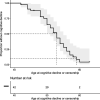Phenotype and imaging features associated with APP duplications
- PMID: 37170141
- PMCID: PMC10173644
- DOI: 10.1186/s13195-023-01172-2
Phenotype and imaging features associated with APP duplications
Abstract
Background: APP duplication is a rare genetic cause of Alzheimer disease and cerebral amyloid angiopathy (CAA). We aimed to evaluate the phenotypes of APP duplications carriers.
Methods: Clinical, radiological, and neuropathological features of 43 APP duplication carriers from 24 French families were retrospectively analyzed, and MRI features and cerebrospinal fluid (CSF) biomarkers were compared to 40 APP-negative CAA controls.
Results: Major neurocognitive disorders were found in 90.2% symptomatic APP duplication carriers, with prominent behavioral impairment in 9.7%. Symptomatic intracerebral hemorrhages were reported in 29.2% and seizures in 51.2%. CSF Aβ42 levels were abnormal in 18/19 patients and 14/19 patients fulfilled MRI radiological criteria for CAA, while only 5 displayed no hemorrhagic features. We found no correlation between CAA radiological signs and duplication size. Compared to CAA controls, APP duplication carriers showed less disseminated cortical superficial siderosis (0% vs 37.5%, p = 0.004 adjusted for the delay between symptoms onset and MRI). Deep microbleeds were found in two APP duplication carriers. In addition to neurofibrillary tangles and senile plaques, CAA was diffuse and severe with thickening of leptomeningeal vessels in all 9 autopsies. Lewy bodies were found in substantia nigra, locus coeruleus, and cortical structures of 2/9 patients, and one presented vascular amyloid deposits in basal ganglia.
Discussion: Phenotypes associated with APP duplications were heterogeneous with different clinical presentations including dementia, hemorrhage, and seizure and different radiological presentations, even within families. No apparent correlation with duplication size was found. Amyloid burden was severe and widely extended to cerebral vessels as suggested by hemorrhagic features on MRI and neuropathological data, making APP duplication an interesting model of CAA.
Keywords: APP duplication; Alzheimer disease; Autosomal dominant; Cerebral MRI; Cerebral amyloid angiopathy.
© 2023. The Author(s).
Conflict of interest statement
The authors declare that they have no competing interests.
Figures



References
MeSH terms
Substances
LinkOut - more resources
Full Text Sources
Medical

